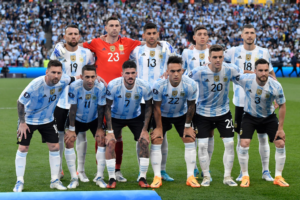Argentina has long been a fertile ground for footballing talent, producing legends like Diego Maradona and Lionel Messi. However, in recent years, there has been a noticeable surge in young talent emerging from the South American nation. This new generation of players is not only maintaining Argentina’s footballing legacy but also setting new standards on the global stage. This article explores the factors behind this rise, profiles some of the standout young talents, and examines the implications for the future of Argentine football.
Football fans visit Xoilac to learn about all the new football players of Argentina Football Club and watch them play.
Historical Context: Argentina’s Footballing Heritage
Argentina’s passion for football is deeply embedded in its culture. The country has produced some of the greatest footballers of all time, and its domestic league, the Primera División, has been a breeding ground for talent. The success of the national team, with World Cup victories in 1978 and 1986, further solidified Argentina’s reputation as a football powerhouse.
The Argentine Football Association (AFA) has historically invested in youth development, with clubs like River Plate and Boca Juniors known for their prolific youth academies. These academies have been crucial in nurturing talent and providing a pathway to professional football. The country’s footballing philosophy, which emphasizes technical skill, creativity, and flair, has also played a significant role in the development of young players.
Factors Contributing to the Rise of Young Talent
Several factors have contributed to the recent surge in young Argentine footballers making a mark on the global stage:
- Improved Youth Development Programs: The AFA has revamped its youth development programs, focusing on modern training techniques, better facilities, and comprehensive player education. This holistic approach ensures that young players are not only skilled on the pitch but also mentally and physically prepared for the demands of professional football.
- Exposure to European Football: Many young Argentine players are now moving to Europe at an earlier age. This exposure to high-level competition and advanced training methods accelerates their development. Clubs like Ajax, Barcelona, and Borussia Dortmund have become popular destinations for young Argentine talent.
- Increased Scouting and Recruitment: European clubs have intensified their scouting efforts in Argentina, recognizing the country’s potential as a talent hub. This has led to a more structured pathway for young players to transition from local leagues to top European clubs.
- Technological Advancements: The use of technology in training and performance analysis has become more prevalent. Young players have access to video analysis, performance tracking, and other tools that help them improve their game.
Profiles of Promising Young Talents
1. Thiago Almada
Thiago Almada, born in 2001, is one of the most exciting young prospects in Argentine football. Currently playing for Atlanta United in Major League Soccer, Almada has been lauded for his dribbling skills, vision, and ability to score from midfield. His performances have attracted interest from several top European clubs, and it seems only a matter of time before he makes a move to one of the major leagues.
2. Julián Álvarez
Julián Álvarez, a product of River Plate’s youth academy, has quickly established himself as one of the brightest young forwards in South America. Known for his versatility, Álvarez can play both as a winger and a central striker. His clinical finishing and intelligent movement have made him a key player for River Plate, and he has already made his debut for the senior national team.
3. Matías Palacios
Matías Palacios, another gem from the San Lorenzo youth academy, is a midfielder with exceptional technical abilities. Born in 2002, Palacios has been a standout performer in youth international tournaments, showcasing his passing range, vision, and creativity. His potential has caught the eye of several European scouts, and a move abroad seems imminent.
4. Facundo Medina
Facundo Medina, a left-footed central defender, has been making waves in European football with his performances for RC Lens in Ligue 1. Medina’s composure on the ball, defensive intelligence, and leadership qualities have earned him a place in the national team setup. He represents the new breed of modern defenders who are comfortable playing out from the back.
5. Adolfo Gaich
Adolfo Gaich, a powerful striker, has been compared to Argentine greats like Gabriel Batistuta for his playing style. After impressing at San Lorenzo, Gaich made a move to Europe, where he currently plays for CSKA Moscow. His physicality, aerial ability, and goal-scoring instincts make him a formidable presence in the attacking third.
For Vietnamese football fans, this website Xoi lac can be very helpful for you to watch football games with commentary in Vietnamese language.
The Impact on Argentine Football
The rise of young talent in Argentina has significant implications for the future of the national team and domestic football. With a steady pipeline of gifted players, Argentina is well-positioned to compete at the highest levels for years to come.
1. Revitalizing the National Team
The influx of young talent has already begun to rejuvenate the national team. Players like Julián Álvarez and Facundo Medina have integrated seamlessly into the senior setup, adding depth and dynamism. This new generation, combined with experienced stars like Lionel Messi and Ángel Di María, creates a balanced squad capable of competing for major honors.
2. Boosting Domestic Leagues
The Primera División and other domestic leagues benefit from the presence of young stars. These players attract attention from fans and scouts alike, raising the profile of the league. Moreover, successful transfers of young talent to Europe bring financial benefits to the clubs, which can be reinvested in further development.
3. Strengthening Youth Academies
The success of young players reinforces the importance of youth development programs. Clubs are motivated to invest more in their academies, knowing that they can produce players capable of achieving success both domestically and internationally. This creates a virtuous cycle of talent development and success.
Challenges and Opportunities
While the rise of young talent in Argentina is promising, there are challenges that need to be addressed to sustain this growth:
- Balancing Early Moves to Europe: While moving to Europe can accelerate development, it also comes with risks. Young players may struggle to adapt to new environments and face intense competition. Ensuring that they receive adequate support and opportunities for playing time is crucial.
- Maintaining Domestic Competitiveness: The constant export of top talent to Europe can weaken domestic leagues. It’s important for Argentine clubs to find a balance between nurturing young players and retaining experienced ones to maintain competitiveness.
- Supporting Grassroots Football: Continued investment in grassroots football is essential to ensure a steady supply of young talent. Initiatives to promote football at the grassroots level, particularly in underserved areas, can unearth hidden gems.
Conclusion
The rise of young talent in Argentine football is a testament to the country’s rich footballing culture and commitment to youth development. With improved training programs, increased exposure to European football, and a strong scouting network, Argentina is producing a new generation of players ready to make their mark on the global stage. The success of these young stars not only revitalizes the national team but also strengthens domestic football. As long as the challenges are addressed and opportunities leveraged, the future of Argentine football looks brighter than ever.


